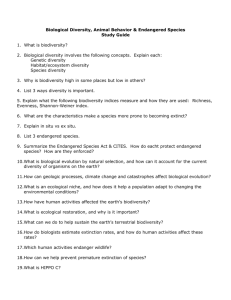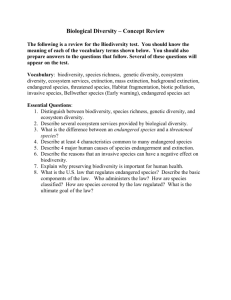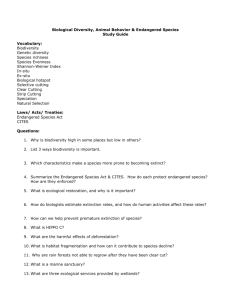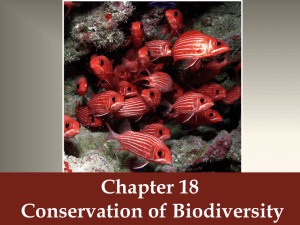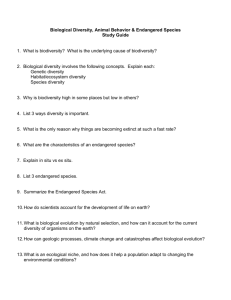EnviSciChap 10 PPT 2011
advertisement
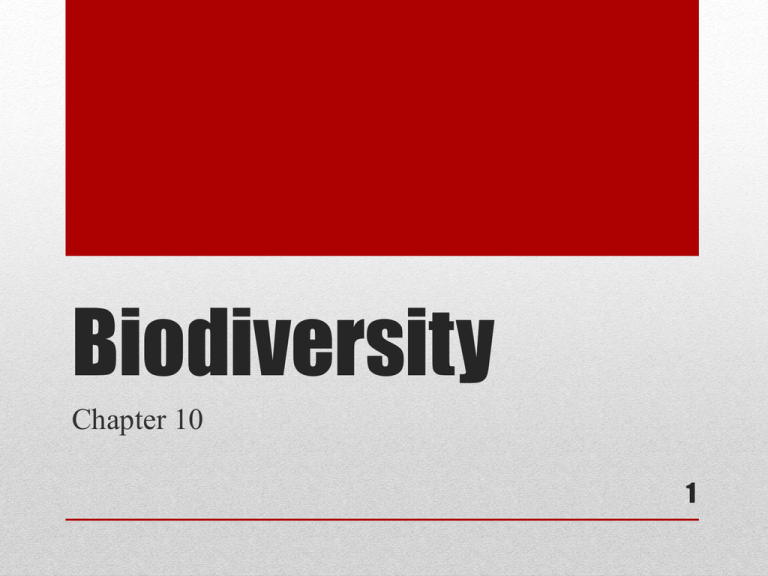
Biodiversity Chapter 10 1 Section 1 What is Biodiversity 2 Biodiversity – the number of different species in a given area Tropical rain forests have highest biodiversity on earth Known species – species that are collected and described scientifically 1.7 million species (most of which are insects) Unknown species – Species not identified as of yet, located in remote locations More than 2 million possible (to be identified) Levels of diversity Species diversity : Number of species in a given area (most commonly know as biodiversity) Ecosystem diversity: All the different habitats and ecological processes in an ecosystem Genetic diversity: All the different genes in all the members of a population A gene is a part of DNA that determines one particular trait (blue eyes, widow peak) A World Rich in Biodiversity 3 • Species are connected to ecosystems. • Every species is either dependent on or depended upon by at least one other species. • Think food webs, niches • Keystone species – critical to the entire ecosystem • Sea Otters: loss of the otter - led to the loss of kelp beds Benefits of Biodiversity 4 Species and Population Survival • Genetic diversity is critical to species survival. • Environmental changes affect less diverse populations more • Ice Age – species not adapted to cold die - but species with genes to survive cold live on • If no one in species had cold gene, all die • But what happens to genes in all the species that died? • All other genes lost Bottleneck effect – When a population is reduced to a few members. Only certain genes get through the event. Benefits of Biodiversity 5 • Medicines and cures are constantly being found as we locate new species • Industry finds new chemicals in all types of species • Better resistant crops being made because of genetic crossing • Ethics, Aesthetics, and Ecotourism • Should we preserve species because they deserve to be here? • Should we preserve species because they are nice to look at and make our lives beautiful • Ecotourism – a form of tourism that supports the conservation and sustainable development of ecologically unique areas. 6 • Time for a reading quiz That’s all for 10.1 7 Section 2 Biodiversity at Risk 8 • Mass extinction – extinction of many species in a short period of time • Five previous mass extinction events • Due to global climate change • Dinosaurs: ice ages and meteorites • Possible cause of the next (current??)mass extinction: • Due to human activities • From 1800 to 2100 up to 25% of all species may become extinct • Endangered species – species that will go extinct if not protected immediately • Usually a small population in a limited habitat • Threatened species – species will become endangered if not protected Current Extinctions 9 • Habitat Destruction and Fragmentation • We use land for homes and food production • In the process – we destroy and fragment the habitats of other species. • Habitat loss is causing 75% of all current extinctions • Florida Panther: one of the most endangered species in North America (due to habitat loss) How Do Humans Cause Extinctions 10 Invasive species • New species introduced to an environment • Native species have no defenses, and new species have no predators • Kudzu, Cane Toads, Fire Ants • Harvesting, Hunting, Poaching • Passenger pigeon hunted out of existence, bison close • People want rare species as a pet, food, medicine • Monkey brains, shark fins, • Poaching – capturing protected species against the law • Ex: elephants for ivory (tusk) ; tigers for healing properties Pollution • Chemicals being dumped have harmful effects on other species Ex: DDT in the food chain caused bald eagle egg shells to weaken • Bald eagle nearly extinct until DDT banned. 11 How Do Humans Cause Extinctions • Endemic Species – species that live in a small specific habitat • Tropical Rain Forest • Home to half of world’s species • Most not yet observed, but losing them as we clear the rain forest for farming and housing • Coral Reefs – Most of biodiversity in ocean • A major source of food and ecotourism • In danger due to overfishing, and pollution • Hot Spots – the most threatened areas of high diversity on Earth • Madagascar, Philippines, Florida Everglades, California Coast, Hawaii • United States Biodiversity • We have several of the hotspots (Florida Everglades / coastal regions) • Are we taking care of them? 12 Areas of Critical Biodiversity • Time for a reading quiz That’s all for 10.2 13 Section 3 The Future of Biodiversity14 • When a species is nearing extinction what can be done to help? • Captive breeding • Species are bred in captivity (zoos or shelters) and will be released into wild when enough are bred • California Condor • Preserving Genetic Material • Germ plasm – genetic material from reproductive cells • Stored (usually frozen) for future use. • Same as heirloom tomato seeds! • Zoos and Aquariums • Not just for entertainment • Home for endangered species • Successful breeding programs - Pandas! 15 Saving Species One at a Time • Conservation Strategies • Focus on whole ecosystem not individual species • Restore native habitats and expand them • Legal Protections - US • Endangered Species Act – passed in 1973 • Fish and Wildlife Service must keep list of all endangered or threatened species • Endangered and threatened species cannot be caught or killed. Endangered/threatened plants may not be uprooted No part of an endangered/threatened species may be sold or traded • US Government cannot do any projects that might impact listed species • The U.S. Fish and Wildlife Service must prepare a species recovery plan 16 Preserving Habitats and Ecosystems Legal Protection – International • IUCN – International Union for the Conservation of Nature and Natural Resources Advise governments on endangered species Publishes a “Red Lists” of endangered species around the world • CITES – Convention on International Trade in Endangered Species • Elephant Ivory Tusks – Poachers after them • CITES made a worldwide ban on selling ivory • Elephant poaching dropped • Biodiversity Treaty • Agreement generated during the Earth Summit (1992 – Rio de Janeiro) • Goal is to preserve biodiversity and ensure sustainable/fair use of genetic resources in ALL countries 17 • Time for a reading quiz That’s all for 10.3 18


